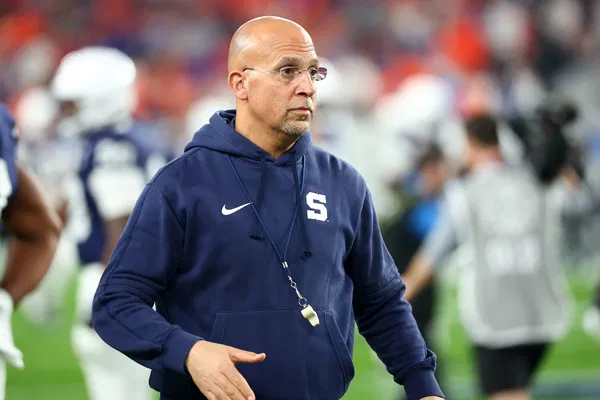James Franklin Must Follow Sarkisian’s Texas Playbook as Drew Allar’s Penn State Frustrations Mount
The 2024 Penn State football season had its highs and lows—beginning with an electrifying road victory against West Virginia but concluding in disappointment with a crushing loss to Notre Dame in the Orange Bowl. On the surface, the Nittany Lions had a respectable season, finishing with just two regular-season losses and making it to a New Year’s Six bowl. But beneath that, a nagging reality lingers: another year with no championship hardware to show for their efforts. The question is, where did it all go wrong?
Penn State’s Offensive Conundrum
The numbers tell an intriguing tale. Penn State’s offense ranked third in total yards per game within their conference—an impressive feat. They dominated on the ground, leading the Big Ten in rushing yards. However, the glaring flaw was in their aerial attack. The team finished a concerning ninth in passing yards per game, raising eyebrows about whether Drew Allar was underperforming or if the offensive play-calling shackled him.
Analyst Thomas Frank Carr dissected the issue, pinpointing a fundamental flaw in how Penn State approached passing situations. “Every RPO is a decision, and that decision is dictated by the defense. I have a feeling there were some 50-50 opportunities where Drew Allar read the situation as a pass but opted to hand off anyway. Sure, they got yards, but if you want to supercharge the passing game, you need to be more aggressive with the RPOs. It’s a simple fix.”
But is it truly that simple? And how does Penn State evolve from a good offense to an elite one?
The Steve Sarkisian Blueprint: Texas-Sized Aggression
If there’s one coach who has mastered the art of explosive, high-risk, high-reward offensive play-calling, it’s Texas Longhorns’ Steve Sarkisian. His approach isn’t just about running an offense—it’s about dictating every aspect of the game and keeping defenses on their heels.
Carr believes Penn State should study Sarkisian’s Texas playbook and integrate its principles into their strategy. “Texas thrives on dynamically aggressive down-the-field RPO situations. They don’t just use RPOs to gain a few yards here and there. They weaponize them, creating big-play opportunities by targeting receivers in one-on-one matchups. Andy Kotelnicki (Penn State’s OC) has the ability to distort defensive structures with motions, shifts, and formations. If they want to take the next step, this is how.”
Sarkisian’s system is a masterclass in deception. He exploits zone coverage, forcing defenses into man-to-man situations where his receivers’ speed and agility give them the edge. He then maximizes the effectiveness of crossing routes, stretching defenders thin and allowing his playmakers to operate in open space. But his brilliance doesn’t end there. He strategically mixes in running plays disguised as passing plays, utilizing back receivers as blockers to clear running lanes. This multi-dimensional attack keeps defenses guessing and unable to commit fully to stopping either the run or the pass.
Sarkisian’s Offensive Wizardry in Action
One of the best examples of Sarkisian’s tactical genius came during Texas’ matchup against Texas A&M. In that game, quarterback Quinn Ewers delivered a precise and controlled performance, racking up 218 passing yards with Quintrevion Wisner and Mathew Golden executing devastating RPO plays. The result? A commanding 17-7 victory.
Central to Sarkisian’s success is the use of the “purple tag” concept, a clever mechanism where a blocking scheme mimics a run while setting up a passing opportunity. It’s the kind of unpredictability that has made Texas’ offense one of the most feared in college football.
Can Franklin Implement This at Penn State?
If James Franklin hopes to break through the Big Ten’s glass ceiling, he must embrace a similar philosophy. Penn State already has the weapons to execute this strategy—Nick Singleton and Kaytron Allen in the backfield, Wallace at receiver, and a quarterback with a cannon for an arm. The question is whether Franklin and Kotelnicki are willing to loosen the reins and allow Allar to fully take charge of the offense.
And speaking of Drew Allar, 2025 will be a pivotal year for him. The highly touted quarterback showed flashes of brilliance in 2024, finishing with a 66.5% completion rate and 3,327 passing yards. But the frustration was evident—he wasn’t being utilized to his full potential. Now, with Beau Pribula transferring to Missouri, the depth chart at QB is suddenly thinner than Franklin would like.
This makes Franklin’s decision-making even more critical. If he continues playing it safe, Penn State will remain a “good” team but never an elite one. If he embraces a more aggressive, Sarkisian-like approach, Penn State could finally be ready to crash the College Football Playoff party.
One thing is certain—Drew Allar’s time is running out, and Franklin must decide whether to let him thrive or keep him shackled in a conservative system. The blueprint is there. The pieces are in place. But will Penn State dare to take the leap?
